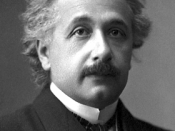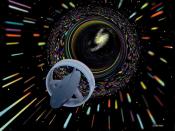Deep Space Travel: Breaking Einstein's Speed Limit Einstein's theories of relativity state that you cannot travel greater than or equal to the speed of light. Some people say- ok we'll just travel to the stars slower than she speed of light. Wrong! The closest star, Alpha Centauri is 9 light-years away (that is nine years at 300,000 Km/S, the speed of life). We could send probes at relatively (no pun intended) slow speeds but the delay in the information gathered would be great because even information can only travel at the universal speed limit. But when someone makes a statement that something cannot be done, and actually has no experimental proof of their assertion there are going to be many doubtful piers. This paper will be divided into 2 main parts. Rebellious Travel will be one (the spacecraft whose pilots have that lead foot and make Einstein turn over in his grave) which is also the most hypothetical piece in the whole puzzle we call relativity.
And the other will be travel that conforms to Einstein's laws and actually uses them to its advantage. I will write about the forms of travel that defy Einstein because my favorite T.V. show of all time is Star Trek and they're always hopping around at the speed of light to the Nth power.
Travel faster than the speed of light Ever since the day Einstein proposed his theory of relativity people have been trying to figure out ways to either disprove him on the speed of light being the universal maximum or alter the conditions enough that the speed limit doesn't apply. In the 85 years since it's proposition no one has been able to disprove it so any physicist with present knowledge would agree with me, at least to the limits of known facts that travel than the speed of light simply cannot happen in normal space. Einstein also proposed many things that provided him ways to avoid being limited by his own speed limit. He said that his laws could only work in the normal existence that we live in- called the Space-Time Continuum. Well, what if we some how altered this continuum? The first thing we need to do is define this "space-time." Space-Time is simply the normal 4 dimensional world we live in. If you ask many people they will tell you there are 3 dimensions, but they don't include time in the equation, something Einstein did in his creation of the Theory of Relativity. There is actually a large number of Dimensions in the universe but only the basic 4 are needed for my purposes. Even if you have a space-craft with some huge, almost infinite source of energy, in normal space-time you would only be able to get to .9999 continuing C (the speed of light) Even at that speed you would still have huge problems but those will be dealt with in the second section.
To move faster than the speed of light you need to either artificially suspend the Space-Time continuum or find a natural distortion and use it to your advantage. We have all seen the science fiction movies where natural phenomena "suck up" a spacecraft and send it to distances previously thought unimaginable. 2 Star Trek series were based on this concept and an episode of the Next Generation had a Time Traveler use his own powers to throw the Enterprise D into different realities. The two series I was referring to before were Voyager, where a mysterious being tosses the ship all the way to the Delta quadrant, and Deep Space Nine which is based on a space port right next to a worm hole which is a natural phenomena that spans huge distances and is a kind of short cut through space. I am not going to address beings that have the ability to throw spaceships billions of miles, because at this juncture in time we have no proof or possible explanation on how this would happen. But, Worm Holes- That is a very interesting thought and one of the ways that we could travel "faster than the speed of light" even though you wouldn't really be going faster than light just utilizing a natural "short cut" through space.
The possibility of the existence of Worm Holes is solely dependent on one thing, and that is the existence of Curved Space. This is another term that is vital to try to gain an understanding of. To imagine curved space is a very hard thing to do and took me three listening to my "Physics of Star Trek" audiocassette set. To imagine curves space one must imagine space as a piece of paper infinitely wide and long, but not infinitely tall. That piece of paper has many waves like bends in it. If one of these waves is curves so much that it touches the previous bend the point that they touch at can be used as a portal from the bottom of one wave to the bottom of the next- skipping billions, possibly more light-years of travel. I know that model isn't flawless but it is the absolute best way I can explain it.
The possibility of the existence of Worm Holes is solely dependent on one thing, and that is the existence of Curved Space. This is another term that is vital to try to gain an understanding of. To imagine curved space is a very hard thing to do and took me three listenings to my "Physics of Star Trek" audiocassette set. To imagine curves space one must imagine space as a piece of paper infinitely wide and long, but not infinitely tall. That piece of paper has many wave like bends in it. If one of these waves is curves so much that it touches the previous bend the point that they touch at can be used as a portal from the bottom of one wave to the bottom of the next- skipping billions, possibly more light-years of travel. I know that model isn't flawless but it is the absolute best way I can explain it. The movie "Contact" based on the book of the same name utilizes a concept similar to that of a wormhole although it has some errors. However, I am not going to argue with that book because Astronomy great Carl Sagan wrote it and even though I consider myself well informed on these matters I don't think I know more than the greatest Astronomer of this century. Then there is the ever popular "Warp Drive" of the U.S.S. Enterprise, NCC-1701-A thru E, and of course every saga has it's beginning- the NX-01.
This extremely theoretical mode of travel is super advanced in our terms and according to Michio Kaku is still thousands of years from being achieved by human beings. In concept it is extremely simple. The Warp Drive simply creates a warp in space-time where Einstein's laws are no longer present, and then anti-matter is released into a sort of combustion chamber pushing the ship along. Sounds simple right, it is simple except for the fact that we have no idea on how to go about warping Space-Time just a little bit, never mind creating a pocket big enough for a spaceship to fit into it. The anti-matter is a good idea though and can even be created now but only in small amounts and it can only be held for shorter times. I will explore that possibility in the second section of this report. The one problem I've always had is right when the captain whether it is Kirk, Picard, Janeway, or Archer, says engage. When you're going from a dead stop or even moving along at impulse power and accelerate to warp speed in one spectacular flash of light there is usually going to be problems caused by inertia. When I say problems I mean the minor glitch of the entire ship being ripped to pieces along with its entire crew. I know they had something called an inertial dampener but I would really like it if that Science Fiction visionary named Gene Wesley Roddenberry were still alive and could explain to me how his conceptual device works.
Travel Within the Limits of Relativity Slower than Light travel in normal Space-Time is a normal everyday occurrence on Earth. Walking, driving, any kind of movement would fall into this category. Actually, even if you were lying down perfectly still, you would still be moving at a pretty good clip, in many directions. You would be moving as the earth spins on it's axis, as the earth circles the sun, as the sun orbits the center of our galaxy, as the galaxy goes around the center of the Universe. I even skipped a few steps but I believed that the ones I listed were significant for proving my point. All motion is relative. I don't understand why this fact could be the title of a theory that states so much more and things that have much farther reaching consequences than the simple statement that motion is only relative to your position, but I guess even Einstein had to start somewhere. The point that I was trying to make in the beginning of this paragraph was that we imply the early technologies in slower than light travel and are not too far off from exploring great distances even though they would take a long time to evaluate.
Chemical propulsion is the simplest form of space travel we have. It has been implemented since the first rocket was launched. It involves the expulsion of burning gases at a high speed and pressure at the rear of a rocket, and as a result of that widely known postulate- every action has an equal and opposite reaction- the rocket is pushed forwards. Because of the lack of oxygen in Outer Space normal combustion can't take place. A simple problem requires a simple answer if you need oxygen and there is none in space, simply bring it with you. So our boys at NASA developed an ingenious non-polluting way to propel rockets into outer space. That is, to separate the elements of water through electrolysis and use their compressed states to power their rockets through a sustained explosion behind the ship. Until 2 years ago Chemical propulsion was the only way we traveled through space.
In 1998 NASA launched a probe named Deep Space one. The thing that was special about this probe is that after being brought to outer space by a conventional rocket booster it uses a revolutionary ion- propulsion engine. It simply bombards Xenon with electricity and expels the resulting ions out at an incredible 5 miles per second. The engine is much more efficient than a chemical rocket, 10 times to be exact. It achieves this level of efficiency by only applying a tiny force over a long period of time and not loosing very much force at all, unlike chemical rockets, which release huge amounts of energy in a short amount of time.
Other short-term alternatives to chemical propulsion are ships that utilize different types of solar sails that gently pull the ship along by the force of particles that are ejected from the sun. These sails are very slow but very cost efficient. There was a probe sent to Saturn that actually used seven pounds of plutonium to power it. This brings up a whole world of possibilities.
A fusion reactor, not only the answer to all of Earth's energy needs could serve as a power source for deep space ships. We have succeeded in creating fusion many times in an uncontrolled bomb form, but the more use full controlled use of fusion, a reactor is much harder to achieve fusion in. Ok now assuming one of these many forms of space transportation actually gets us close to the speed of light, there are still problems.
According to Einstein the faster someone moves the slower time seems to go for them. An example set of numbers would be, if we were able to get a ship to.99995C and went to Alpha Centauri the round trip to go there and back would take 9 years. One slight problem or benefit (depending on how you look at) is that this 9-year trip would have only seemed to be one month to the people on the ship. This is a great way to pass the time, but think about it when they get back everybody will have aged 8 years and 11 months more than them. So essentially this is Time-Travel it doesn't seem too bad in this example but let's look at one more just to see just how bad this could be. Let's say a ship travels at just a tiny bit slower than the speed of light and leaves Earth on a course for the nearest Galaxy, M-31 the Andromeda Galaxy. They make the round trip and in their minds it takes 48 months. Well, by the time they get back to earth it's probably not there because it is the earth year 4,002,000 A.D. I don't know about you but even to see another galaxy up close I wouldn't give up my family and anyone I ever met for it.
So, all these factors add up to a pretty bleak outlook at the future of interstellar space travel and until some huge discovery is made to go around Einstein's limitations we're not going too far. But I look up at the stars and am always expecting the Vulcans to come down and give us the technology we need.





